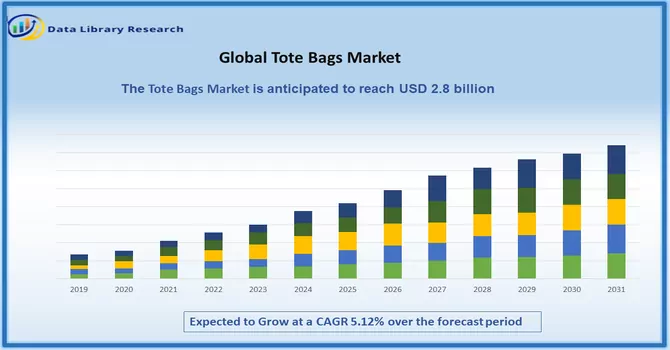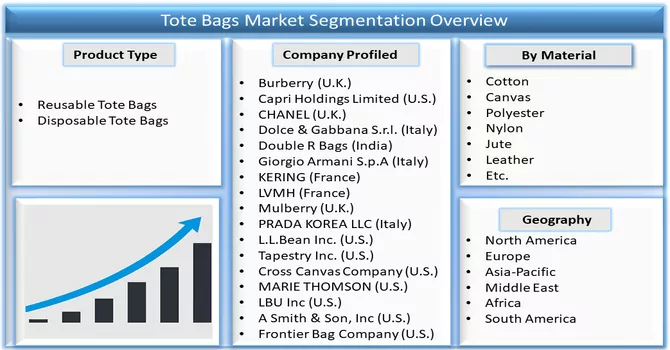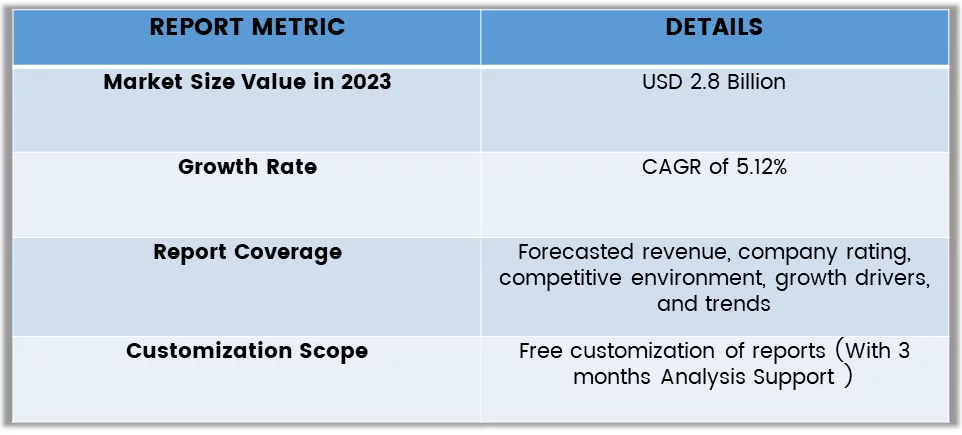The tote bags market value will cross USD 2.8 billion in the year 2024, and expected to register a CAGR of 5.12% during the forecasted period of 2024-2031.

Get Complete Analysis Of The Report- Download Free Sample PDF
The global tote bags market has witnessed significant growth in recent years, driven by a combination of fashion trends, eco-conscious consumer preferences, and the versatile functionality of tote bags. Tote bags, known for their spacious design and durability, have become a popular choice for consumers seeking a stylish yet practical accessory for various purposes.
The market has experienced a surge in demand for eco-friendly and sustainable tote bags, reflecting the growing awareness of environmental issues. Additionally, customization options offered by manufacturers, along with innovative designs and materials, contribute to the market's dynamism. The fashion industry's emphasis on promoting reusable and recyclable products has further fueled the adoption of tote bags. As a result, the global tote bags market continues to evolve, shaped by changing consumer behaviors and the ongoing commitment to sustainable and fashionable accessories. The growth of the global tote bags market is primarily driven by the increasing emphasis on sustainable and eco-friendly lifestyles. With rising environmental awareness, consumers are actively seeking alternatives to single-use plastic bags, and tote bags, being reusable and durable, have gained popularity. The fashion industry's pivot towards sustainability has also played a crucial role, with many brands incorporating eco-friendly materials and manufacturing practices in tote bag production. Customization options offered by manufacturers, allowing consumers to express their personal style, contribute to the market's appeal. Additionally, the versatility of tote bags, suitable for various occasions from shopping to travel, adds to their widespread adoption. As consumers prioritize environmentally conscious choices and fashion-forward accessories, the global tote bags market is expected to experience continued growth.
Market Segmentation: The global tote bags market is Segmented by Materials (Cotton, Canvas, Polyester, Nylon, and Others (jute, leather, etc.)), Product Type (Reusable Tote Bags and Disposable Tote Bags) and Region (North America, Europe, Asia-Pacific, South America and Middle East & Africa).

For Detailed Market Segmentation - Download Free Sample PDF
In the global tote bags market, several notable trends are shaping consumer preferences and industry dynamics. One prominent trend is the growing demand for personalized and customizable tote bags. Consumers increasingly seek unique and individualized products, prompting manufacturers to offer customization options, including personalized prints, colors, and designs. Sustainability continues to be a key trend, with a rising focus on eco-friendly materials such as organic cotton, recycled fabrics, and biodegradable alternatives. Brands are integrating sustainability into their marketing strategies to align with environmentally conscious consumer values. Furthermore, collaborations between fashion brands and artists/designers for limited-edition tote bag collections are gaining traction, creating exclusive and collectible items. The integration of technology, such as smart features and connectivity, is also emerging as a trend, adding a modern touch to traditional tote bags. These trends collectively reflect the evolving consumer preferences and the industry's commitment to innovation in the global tote bags market.
Market Drivers:
Sustainability Drive
The global tote bags market is witnessing a surge in demand for sustainable and eco-friendly products. As environmental awareness grows, consumers are seeking alternatives to single-use plastic bags, contributing to the popularity of reusable tote bags. Manufacturers are responding by using eco-friendly materials such as organic cotton, recycled fabrics, and biodegradable options. The sustainability drive aligns with consumer values, and businesses are adopting environmentally responsible practices to meet this demand, thereby driving the market.
Personalization Trend
A key driver for the global tote bags market is the increasing preference for personalized and customizable products. Consumers are seeking unique and individualized items that reflect their personal style. Manufacturers in the tote bags market are offering customization options, allowing customers to choose personalized prints, colors, and designs. This trend not only caters to consumer preferences for unique products but also enhances brand loyalty as customers feel a stronger connection to personalized items. The ability to create customized tote bags is a significant driver propelling the market forward.
Market Restraints:
Despite the positive growth factors, the global tote bags market faces certain restraints that can impact its trajectory. One notable challenge is the competition from alternative products and materials. The market for tote bags competes with various substitutes, including backpacks, messenger bags, and other types of reusable bags. The versatility of these alternatives and the evolving consumer preferences pose a threat to the widespread adoption of tote bags. Additionally, the availability of low-cost alternatives, especially in regions with price-sensitive consumers, can hinder the market's growth. Furthermore, issues related to quality and durability may arise, affecting consumer trust in the longevity of tote bags compared to other bag options. Overcoming these challenges requires strategic marketing, emphasizing the unique value propositions of tote bags and addressing concerns related to competition and product durability.
The global tote bags market experienced a notable impact from the COVID-19 pandemic. With widespread lockdowns, disruptions in supply chains, and changes in consumer behavior, the market faced both challenges and opportunities. The initial phase of the pandemic led to a decline in consumer spending, affecting the overall demand for non-essential items, including fashion accessories like tote bags. Many retail outlets were temporarily closed, and e-commerce faced logistical challenges, impacting the distribution channels for tote bags.However, as the situation evolved, there was an increased emphasis on sustainable and eco-friendly products, including tote bags. The pandemic highlighted the importance of reusable items, driven by concerns about hygiene and environmental consciousness. Tote bags, known for their durability and eco-friendly nature, gained traction as people sought alternatives to single-use plastics. E-commerce platforms became crucial for the market's recovery, enabling consumers to purchase tote bags online. Overall, while the initial phase brought about challenges, the global tote bags market demonstrated resilience and adaptability, aligning with changing consumer preferences and sustainability trends amid the ongoing pandemic.
Segmental Analysis:
Cotton Segment is Expected to Witness Significant Growth over The Forecast Period
Cotton tote bags are a prominent segment in the global tote bags market, valued for their durability, eco-friendliness, and versatility. As consumers increasingly prioritize sustainability, the demand for cotton tote bags continues to rise, especially in regions like North America and Europe where environmental consciousness is high. The market is driven by factors such as the ban on single-use plastic bags, the promotion of reusable products, and the growing trend of eco-conscious shopping. Manufacturers are focusing on offering stylish designs and customization options to attract customers. The distribution channels for cotton tote bags include both online and offline retail, with online sales witnessing significant growth due to the convenience of e-commerce platforms. In terms of region, North America and Europe are major markets for cotton tote bags, with Asia-Pacific showing potential for growth as awareness about environmental issues increases.
Reusable Tote Bags Segment is Expected to Witness Significant Growth over The Forecast Period
Reusable tote bags offer a sustainable alternative to single-use plastic bags, reducing environmental impact and waste. Their durability ensures they can be used multiple times, offering long-term cost savings. With a wide range of designs and customization options, tote bags are not only practical but also fashionable, serving as a statement accessory. Their versatility makes them ideal for various purposes, from shopping to carrying books or beach essentials. Additionally, supporting local manufacturers or artisans when purchasing tote bags can contribute to local economies and reduce carbon emissions from shipping.
North America Region is Expected to Witness Significant Growth over The Forecast Period
North America plays a significant role in the global tote bags market, driven by a strong trend towards sustainability and reducing plastic waste. The region's stringent regulations and increasing consumer awareness about environmental issues have led to a growing preference for reusable tote bags over single-use plastic bags. This shift is evident in the retail sector, where major grocery chains and stores are promoting the use of reusable bags. The market in North America is also influenced by fashion trends, with consumers opting for tote bags that reflect their personal style. Online retail channels are experiencing significant growth, offering a convenient platform for consumers to purchase a variety of tote bag designs. With the emphasis on sustainability expected to continue, the North American tote bags market is poised for further expansion, contributing to the global effort to reduce plastic pollution.

Get Complete Analysis Of The Report- Download Free Sample PDF
The analyzed market exhibits a high degree of fragmentation, primarily attributable to the presence of numerous players operating on both a global and regional scale. The competitive landscape is characterized by a diverse array of companies, each contributing to the overall market dynamics. This fragmentation arises from the existence of specialized solution providers, established industry players, and emerging entrants, all vying for market share. The diversity in market participants is underscored by the adoption of various strategies aimed at expanding the company presence. On a global scale, companies within the studied market are strategically positioning themselves through aggressive expansion initiatives. This often involves entering new geographical regions, targeting untapped markets, and establishing a robust global footprint. The pursuit of global expansion is driven by the recognition of diverse market opportunities and the desire to capitalize on emerging trends and demands across different regions. Simultaneously, at the regional level, companies are tailoring their approaches to align with local market dynamics. Regional players are leveraging their understanding of specific market nuances, regulatory environments, and consumer preferences to gain a competitive edge. This regional focus allows companies to cater to the unique needs of local clientele, fostering stronger market penetration. To navigate the complexities of the fragmented market, companies are implementing a range of strategies. These strategies include investments in research and development to stay at the forefront of technological advancements, mergers and acquisitions to consolidate market share, strategic partnerships for synergies, and innovation to differentiate products and services. The adoption of such multifaceted strategies reflects the competitive nature of the market, with participants continually seeking avenues for growth and sustainability. In essence, the high fragmentation in the studied market not only signifies the diversity of players but also underscores the dynamism and competitiveness that drive ongoing strategic maneuvers. As companies explore various avenues for expansion, the market continues to evolve, presenting both challenges and opportunities for industry stakeholders.
Some of the key market players are:
Recent Developments:
1) In 2020, Samsonite International S.A. finalized its acquisition of eBags, a prominent digital retailer specializing in bags. This strategic move has positioned the company to significantly impact the online retail sector of the global tote bag market. By leveraging eBags' expertise and established online platform, Samsonite is poised to dominate this segment, offering a wide range of tote bags to a global audience. This acquisition is expected to drive growth in the global tote bags market by expanding the availability and visibility of tote bags online, attracting a larger customer base, and increasing overall market demand. Samsonite's strong brand presence and eBags' digital retail capabilities create a synergy that is likely to drive significant growth and innovation in the tote bag market, benefiting both the company and consumers alike.
2) In April 2023, the sustainable fashion brand Rashki from India collaborated with Atma Leather to launch India's first collection of banana leather handbags. This partnership is expected to have a significant impact on the global tote bags market. Rashki's introduction of a diverse range of bags crafted from Banofi, including the Snow black and white crossbody bag, the environmentally-conscious Unica Eco handbag with elegant wooden handles, and the versatile Fede tote bag, demonstrates a strong commitment to sustainability and innovation. This collection is likely to attract environmentally conscious consumers looking for stylish and eco-friendly alternatives to traditional leather bags. The collaboration between Rashki and Atma Leather not only promotes sustainable fashion but also showcases the potential of banana leather as a viable material for high-quality tote bags. This initiative is expected to drive growth in the global tote bags market by expanding the market for eco-friendly alternatives and inspiring other brands to explore sustainable materials and practices.
Q1. What is the current Tote Bags Market size?
As per Data Library Research the tote bags market value will cross USD 2.8 billion.
Q2. At what CAGR is the market projected to grow within the forecast period?
Tote Bags Market expected to register a CAGR of 5.12% during the forecasted period.
Q3. Which Region is expected to hold the highest Market share?
North America region is expected to hold the highest Market share.
Q4. Who are the key players in Tote Bags Market?
Some key players operating in the market include
Data Library Research are conducted by industry experts who offer insight on industry structure, market segmentations technology assessment and competitive landscape (CL), and penetration, as well as on emerging trends. Their analysis is based on primary interviews (~ 80%) and secondary research (~ 20%) as well as years of professional expertise in their respective industries. Adding to this, by analysing historical trends and current market positions, our analysts predict where the market will be headed for the next five years. Furthermore, the varying trends of segment & categories geographically presented are also studied and the estimated based on the primary & secondary research.
In this particular report from the supply side Data Library Research has conducted primary surveys (interviews) with the key level executives (VP, CEO’s, Marketing Director, Business Development Manager and SOFT) of the companies that active & prominent as well as the midsized organization
FIGURE 1: DLR RESEARH PROCESS

Extensive primary research was conducted to gain a deeper insight of the market and industry performance. The analysis is based on both primary and secondary research as well as years of professional expertise in the respective industries.
In addition to analysing current and historical trends, our analysts predict where the market is headed over the next five years.
It varies by segment for these categories geographically presented in the list of market tables. Speaking about this particular report we have conducted primary surveys (interviews) with the key level executives (VP, CEO’s, Marketing Director, Business Development Manager and many more) of the major players active in the market.
Secondary ResearchSecondary research was mainly used to collect and identify information useful for the extensive, technical, market-oriented, and Friend’s study of the Global Extra Neutral Alcohol. It was also used to obtain key information about major players, market classification and segmentation according to the industry trends, geographical markets, and developments related to the market and technology perspectives. For this study, analysts have gathered information from various credible sources, such as annual reports, sec filings, journals, white papers, SOFT presentations, and company web sites.
Market Size EstimationBoth, top-down and bottom-up approaches were used to estimate and validate the size of the Global market and to estimate the size of various other dependent submarkets in the overall Extra Neutral Alcohol. The key players in the market were identified through secondary research and their market contributions in the respective geographies were determined through primary and secondary research.
Forecast Model
